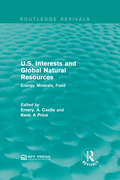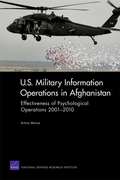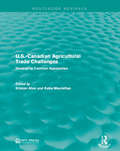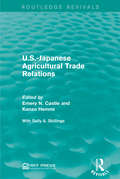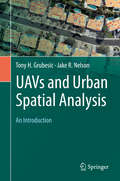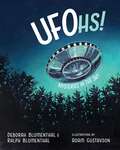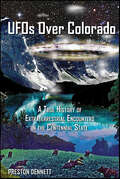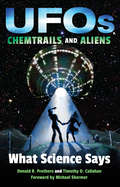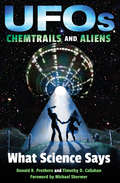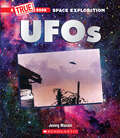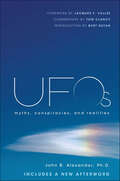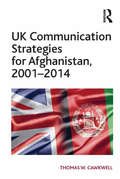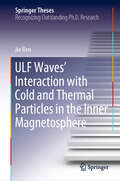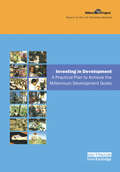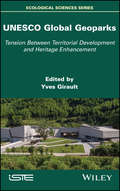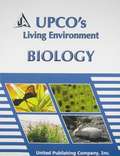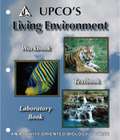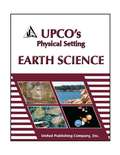- Table View
- List View
U.S. Interests and Global Natural Resources: Energy, Minerals, Food (Routledge Revivals)
by Kent A. Price Emery N. CastleOriginally published in 1983, U.S. Interests and Global Natural Resources explores the links between foreign policy and the global distribution of natural resources paying particular attention to the U.S. This collection of essays delves into the importance of factors such as differing economic development and political hostility could have on the provision of resources into the U.S and advises that nations identify their countries needs and establish policies to safeguard them. This title will be of interest to students of Environmental Studies and Policy makers.
U.S. Military Information Operations in Afghanistan: Effectiveness of Psychological Operations 2001-2010
by Arturo MunozThe U. S. Marine Corps, which has long recognized the importance of influencing the civilian population in a counterinsurgency environment, requested an evaluation of the effectiveness of thepsychological operations element of U. S. military information operations in Afghanistan from 2001 to 2010 based on how well messages and themes were tailored to target audiences. This monograph responds to that request.
U.S.-Canadian Agricultural Trade Challenges: Developing Common Approaches (Routledge Revivals)
by Kristen Allen Katie MacmillanThe Free Trade Agreement between the United States and Canada was established in 1988 despite the U.S.’s controversial proposal to eliminate trade-distorting government subsidies to agriculture. Originally published in 1988, this volume brings together a collection of essays which identify and debate the difficulties associated with agricultural trade between the U.S. and Canada and explore common interests in the resolution of global agricultural issues. This title is a valuable resource for students interested in environmental studies and international agricultural relations.
U.S.-Iran Engagement in Science, Engineering, and Health (2000-2009): Opportunities, Constraints, and Impacts
by National Research Council of the National AcademiesDuring the first decade of the 21st century, the National Academies, working with a number of partner organizations in Iran, carried out a program of U.S.-Iran engagement in science, engineering, and health (herein referred to as science engagement). This book reviews important aspects of the science engagement program, including: (a) objectives of the program, (b) opportunities and constraints in developing the program, and (c) scientific and political impacts of the activities. Suggestions for future activities that draw on the conclusions and recommendations that have emerged from workshops and other types of interactions are set forth. Of course, the political turmoil within Iran and uncertainties as to the direction of U.S.-Iran government-to-government relations will undoubtedly complicate initiation and implementation of new science engagement activities in the near term. At the same time, many American and Iranian participants and important government officials in the United States and Iran have believed that science engagement can contribute to the evolution of an improved political environment for development of less adversarial relations between the two governments.
U.S.-Japanese Agricultural Trade Relations (Routledge Revivals)
by Emery N. Castle Kenzo Hemmi Sally A. SkillingsFirst published in 1982, the editors and authors of this book examine the United States’ 1973 embargo on the export of soybeans and its effects on U.S.-Japanese relations. Although eventually shipment of soybeans to Japan resumed, the embargo temporarily soured the friendly relations of the two democracies. This book, prepared by a group of Japanese and U.S. scholars, demonstrates how trade relations between the two countries are affected by their internal political situations and by the nature of their respective agricultural industries. U.S.-Japanese Agricultural Trade Relations will be valuable to scholars, policy makers, and others interested in agricultural trade. It should be particularly useful in courses on international trade and on agricultural policy.
UAVs and Urban Spatial Analysis: An Introduction
by Tony H. Grubesic Jake R. NelsonThis book provides an introduction to the use of unmanned aerial vehicles (UAVs) for the geographic observation and spatial analysis of urban areas. The velocity of urban change necessitates observation platforms that not only enhance situational awareness for planning and allied analytical efforts, but also provide the ability to rapidly and inexpensively collect data and monitor change. UAVs can accomplish both of these tasks, but their use in urban environments is loaded with social, operational, regulatory and technical challenges that must be addressed for successful deployments. The book provides a resource for educators and students who work with geographic information and are seeking to enhance these data with the use of unmanned aerial vehicles. Topics covered include, 1) a primer on UAVs and the many different ways they can be used for geographic observation, 2) a detailed overview on the use of aviation maps and charts for operating UAVs in complex urban airspace, 3) techniques for integrating UAV-derived data with more traditional geographic information, 4) application of spatial analytical tools for urban and environmental planning, and 5) an exploration of privacy and public safety issues associated with UAV operation.
UFO Briefing Document: The Best Available Evidence
by Don BerlinerThe shattering report that stunned the world's top leaders—now available to the public!Are UFOs in our midst? The evidence mounts . . .1952 UFO squadrons over Washington, D.C. Tracked on radar. Visual sightings by military. Verdict: &“Unexplainable.&”1976 UFO dogfight with F-4 Phantom II jets over Tehran. Weapons &“jammed.&” Radar/visual confirmation. Verdict: &“Unavailable: Top Secret.&”1981 UFO lands in Trans-en-Provence. Investigated by French police. Soil samples analyzed. Verdict: &“UFO. No hoax.&”Compiled here are the most compelling and authenticated UFO cases ever recorded. Fresh from the government&’s secret files, spanning over a half century of eyewitness testimony, documented sightings, and unexplained phenomena, this groundbreaking compilation presents the chilling evidence that UFOs are real—and that a government cover-up has long suppressed the stunning truth.Complete with excerpts from official transcripts, diagrams, and photos, UFO Briefing Document, funded by Laurance Rockefeller and presented to Congress, contains critical information the public has a right to know . . . now, before it is too late.
UFOhs!: Mysteries in the Sky (Barbara Guth Worlds of Wonder Science Series for Young Readers)
by Deborah Blumenthal Blumenthal RalphUFOhs! Mysteries in the Sky is the first book to explore the strange, exciting, and unknown world of unidentified aerial phenomena for kids. UFOhs! cuts through speculation and pseudo-science to describe real phenomena as observed and documented by pilots, ship captains, scientists, and ordinary men, women, and children from around the world. Playful, probing, and beautifully illustrated, UFOhs! Mysteries in the Sky prompts kids and their parents to talk about the moon, the stars, the planets, and all the things they see in the sky, and to wonder about those we can&’t yet explain.
UFOs Over Colorado: A True History of Extraterrestrial Encounters in the Centennial State
by Preston DennettColorado has been a UFO hotspot for more than 100 years. This is the first book to present a comprehensive history of extraterrestrial encounters in the Centennial State. Arranged by decade, read a dazzling array of sightings, landings, face-to-face encounters, onboard experiences, and UFO crash/retrievals. Colorado UFO cases have had a profound effect on UFO research. The 1967 mutilation of Lady the horse in Alamosa introduced the world to the animal mutilation phenomenon. The 1995 videotape footage by Tim Edwards of a UFO over Salida remains some of the best evidence ever recorded. The extraterrestrial experiences of Denver businessman Stan Romanek are among the best-verified in UFO history. The San Luis Valley in southern Colorado has produced hundreds of cases and is one of the most active areas on the planet. This book will explore these famous cases and many others never before published.
UFOs and The White House: What Did Our Presidents Know and When Did They Know It?
by William J. Birnes Joel MartinThe author team that wrote the upcoming Skyhorse title Edison vs. Tesla, as well as The Haunting of the Presidents and other titles about the weird, the supernatural, and the unexplained, turn their attention to the oval office for a unique view of UFOs in America and more specifically, what America's presidents--from Washington to Obama--have witnessed and believed. <p><p> Most of us know that George Washington was heavily involved with the secret society the Freemasons. But how many of us know about George Washington's UFO sighting during the terrible winter at Valley Forge, and how the experience guided his future?Marilyn Monroe is rumored to have had UFO intel that she gained via pillow-talk from JFK. <p> Under Nixon's presidency we orbited and walked upon the surface the moon while almost at the same time the Air Force was exploiting the Air Force as scientific cover for its decision to terminate Project Blue Book. Jimmie Carter was visited by UFOs multiple times. UFOs and the White House is an oft-overlooked glimpse at history that will appeal to historians as well as advocates of the paranormal.
UFOs, Chemtrails, and Aliens: What Science Says
by Michael Shermer Donald R. Prothero Timothy D. CallahanUFOs. Aliens. Strange crop circles. Giant figures scratched in the desert surface along the coast of Peru. The amazing alignment of the pyramids. Strange lines of clouds in the sky. The paranormal is alive and well in the American cultural landscape. In UFOs, Chemtrails, and Aliens, Donald R. Prothero and Tim Callahan explore why such demonstrably false beliefs thrive despite decades of education and scientific debunking. Employing the ground rules of science and the standards of scientific evidence, Prothero and Callahan discuss a wide range of topics including the reliability of eyewitness testimony, psychological research into why people want to believe in aliens and UFOs, and the role conspiratorial thinking plays in UFO culture. They examine a variety of UFO sightings and describe the standards of evidence used to determine whether UFOs are actual alien spacecraft. Finally, they consider our views of aliens and the strong cultural signals that provide the shapes and behaviors of these beings. While their approach is firmly based in science, Prothero and Callahan also share their personal experiences of Area 51, Roswell, and other legendary sites, creating a narrative that is sure to engross both skeptics and believers.
UFOs, Chemtrails, and Aliens: What Science Says
by Donald R. Prothero Timothy D. CallahanA wide-ranging survey offers &“entertainment as well as wisdom for everyone who&’s ever wondered what&’s behind so many conspiracy theories and paranormal phenomena&” (Publishers Weekly). UFOs. Aliens. Strange crop circles. Giant figures scratched in the desert surface along the coast of Peru. The amazing alignment of the pyramids. Strange lines of clouds in the sky. The paranormal is alive and well in the American cultural landscape. In UFOs, Chemtrails, and Aliens, Donald R. Prothero and Tim Callahan explore why such demonstrably false beliefs thrive despite decades of education and scientific debunking. Employing the ground rules of science and the standards of scientific evidence, Prothero and Callahan discuss a wide range of topics including the reliability of eyewitness testimony, psychological research into why people want to believe in aliens and UFOs, and the role conspiratorial thinking plays in UFO culture. They examine a variety of UFO sightings and describe the standards of evidence used to determine whether UFOs are actual alien spacecraft. Finally, they consider our views of aliens and the strong cultural signals that provide the shapes and behaviors of these beings. While their approach is firmly based in science, Prothero and Callahan also share their personal experiences of Area 51, Roswell, and other legendary sites, creating a narrative that is sure to engross both skeptics and believers.
UFOs: (a True Book: Space Exploration) (A True Book (Relaunch))
by Jenny MasonFrom the first time a person looked up at the sky and wondered "What's our there?" humans have dreamed about exploring the cosmos.This book is part of a series, A True Book: Space Exploration, that includes the titles Human Missions to Outer Space, Mars Rovers, The International Space Station, and UFO's. The series features the latest NASA imagery and lively text to bring the wonder of space exploration directly to readers.Over the years, there have been hundreds of reports of UFO (or unidentified flying object) sightings—which the U.S. government seemed to ignore. But a recently released Pentagon report tells a different story. For five years, a secret government agency was tracking and investigating these sightings. Now, in the pages of this book, the details of that report can be revealed! Share in the joy of exploration and discovery with UFO's.
UFOs: Generals, Pilots, and Government Officials Go on the Record
by Leslie KeanAn Air Force major is ordered to approach a brilliant UFO in his Phantom jet over Tehran. He repeatedly attempts to engage and fire on unusual objects heading right toward his aircraft, but his missile control is locked and disabled. Witnessed from the ground, this dogfight becomes the subject of a secret report by the U. S. Defense Intelligence Agency. In Belgium, an Air Force colonel investigates a series of widespread sightings of unidentified triangular objects, and he sends F-16s to attempt a cl...
UFOs: Myths, Conspiracies, and Realities
by John B. AlexanderA never-before-heard firsthand account of a government insider's experience on the cutting edge of UFO exploration; includes a new afterword"Forget everything you think you know about UFOs - this insider's account exposes the reality... Packed with top grade information, insightful analysis and fascinating anecdotes, Alexander's interesting and controversial book sets the gold standard for titles on this subject." –Nick Pope, author of Open Skies, Closed Minds"Changes the playing field for both true believers and skeptics alike. Alexander strongly warns, be careful what you wish for when asking for presidential intervention. Success could set the field of ufology back decades." --George Noory, host of Coast to Coast AMWhile still on active duty in the U.S. Army during the 1980s, Colonel John B. Alexander, Ph.D. created an interagency group to explore the controversial topic of UFOs. All members held Top Secret clearance. What they discovered was not at all what was expected. UFOs covers the numerous cases they saw, and answers questions like:• What was really in Hanger 18? • Did a UFO land at Holloman Air Force Base? • What happened at Roswell? • What is Majestic 12? • What is the Aviary? • What does the government know about UFOs? • What has happened with disclosure in other countries? • Has the U.S. reverse engineered a UFO? • Why don't presidents get access to UFO info? UFOs is at once a complete account of Alexander's findings, and a call to action. There are no conspiracy theories here—only hard facts—but they are merely the beginning. Foreword by Jacques F. ValleeIntroduction by Burt RutanCommentary by Tom Clancy
UFOs: Unidentified Aerial Phenomena: Observations, Explanations and Speculations
by Karl SvozilUnidentified phenomena in space, in the Earth's atmosphere, and in waters are too important to leave their exploration to the military and scientific laypersons. Their proper scientific study is important for a variety of reasons; in particular, scientists and the public at large need to know the basic facts, to be informed about the way evidence is recorded, and to understand the difference been reliable evidence and fiction, as well as between plausible explanations and fantasy.With this objective, the book surveys the history of UFO observations, the variety of recorded phenomena, and recounts the efforts of investigative commissions and their published findings.Although wild rumors are demystified in the process, this is not an exercise in rumor-bashing. An open and at the same time critical mindset is the key. Many narratives and hypothesis appear implausible relative to our present state of knowledge; but this alone should not lead to their outright exclusion. Thus the author also pays attention to UFO sightings that have so far eluded explanation in terms of known physics or meteorology. Here the reader will encounter some of the more speculative but scientifically tenable proposals, for example, relating to sudden zigzag motion without apparent inertia or recognizable propulsion, yet always with a clear guide to their plausibility. Last but not least, the book outlines plans and suggestions for future research capable of revealing the existence and intentions of extraterrestrial intelligences, outer-space engineers, or technologies so far known only from science fiction.
UK Communication Strategies for Afghanistan, 2001–2014
by Thomas W. CawkwellThe war in Afghanistan came to an end in 2014 after nearly thirteen years of conflict. Throughout that period, British officials have described UK operations there in various conflicting and often contradictory ways; as a counter-terrorism mission, a stabilisation mission, and a counter-narcotics mission, respectively. This book investigates how the war was ’sold’ to the British public and how Britain’s ’transnational’ foreign and defence policy impacted on the unfolding of UK strategy in Afghanistan and the way it was communicated. It argues that because the UK’s foreign and defence policy is transnationally-oriented - meaning that it is foundationally aimed at maintaining alliance with the United States and the institutional coherence of NATO - UK strategy is contingent upon collective security and, crucially, is fundamentally concerned with the means of policy (maintaining alliances) over the ends (using alliances to effect change). Explaining the inalienability of collective security systems to national security is no easy task, however, and, when faced with the adversities of Afghanistan, the UK state has since 2008 instead opted to describe the significance of Afghanistan in narrow, nation-centric, counter-terrorist concerns in order to maintain public support for collective security operations there whilst, paradoxically, framing the conflict in a manner that avoids talking about the transnational structure and purpose of the mission. This kind of ’strategic’ communication is increasingly becoming a focus of the UK state as it faces a transnational dilemma of maintaining its collective security bonds whilst facing a public increasingly sceptical of liberal interventionism.
ULF Waves’ Interaction with Cold and Thermal Particles in the Inner Magnetosphere (Springer Theses)
by Jie RenThis thesis focuses on ULF (Ultra-low-frequency) waves' interaction with plasmasphere particles and ring current ions in the inner magnetosphere. It first reports and reveals mutual effect between ULF waves and plasmasphere using Van Allen Probes data. The differences and similarities of different ring current ions interacting with ULF waves are extensively explored using Cluster data, which provides a potential explanation for O+-dominated ring current during the magnetic storms. Furthermore, this thesis finds a method to study the phase relationship between ULF waves and drift-bounce resonant particles, and proposes that the phase relationship can be used to diagnose the parallel structure of standing wave electric field and energy transfer directions between waves and particles. The findings in this thesis can significantly promote our understanding of ULF waves' role in the dynamics of inner magnetosphere.
UN Millennium Development Library: A Practical Plan to Achieve the Millennium Development Goals
by Jeffrey D. Sachs The UN ProjectThis book describes the importance of the millennium development goals and gives an explanation of the progress toward the goals. It provides recommendations to be implemented at the country level and presents a guide for the international system's support for the country-level processes.
UNESCO Global Geoparks: Tension Between Territorial Development and Heritage Enhancement
by Yves GiraultRecently, UNESCO has gradually started to recognize world geoparks ? territorial spaces with a geological heritage of international importance. This classification presents real challenges. Development strategies must align with the recommendations advocated by various non-governmental organizations. It is also necessary to involve the local actors, both in the preparation of application forms and in the implementation of a management plan that is suitable for sustainable global development. Managing the tensions and asymmetries that exist between the different groups of actors (politicians, managers, scientists, representatives of local populations) constitutes another major issue. It is in this context and through various case studies that this book questions the aims of the UNESCO global geoparks ? in terms of heritage inventory and conservation, the participation of local populations, the local development of a territory and its enhancement through heritage interpretation.
UPCO's Intermediate Level Science Review
by Amy Schneider Peggy LomagaChapters include: Scientific Method; Chemistry of Matter; Characteristics of Life; Ecology; Physiology; Reproduction and Development; Genetics; Astronomy; Meteorology; Geology; Energy, Forces & Motion; Sound and Electromagnetic Energy.
UPCO's Intermediate Level Science Review
by United Publishing CompanyThe thirteen chapters cover: The Living Environment and The Physical Setting for students in Grades 5 through 8. Along with a General Science Skills Chapter. The chapter review involves application of concepts, reading comprehension, graphing, experimental design and analysis as well as important vocabulary words boldfaced throughout the chapters. It includes the NYS Intermediate Science Test Sampler as well as two additional practice exams at the end of the book.
UPCO's Living Environment Review: Biology
by Lorraine GodlewskiUPCO'S Living Environment Review is a complete review of all the key ideas and major understandings as required by the New York State Living Environment Core Curriculum. Also included is any additional information necessary for total comprehension of core curriculum key ideas.
UPCO's Living Environment: An Activity-oriented Biology Course
by Lorraine GodlewskiBiology is the name of the science that studies living things and their relationship to their environment. You should have a basic scientific knowledge, called scientific literacy, of your living and nonliving environment because scientific literacy involves internalizing a scientific critical attitude that can be applied to your life. It will help you to be better informed when making important decisions about your everyday life, particularly in relation to your health, and to issues concerning commercial and technological claims concerning the environment. Understanding the scientific view of the natural world is an essential part your personal, societal, and ethical decision making. The study of the living environment will also help you understand and apply scientific concepts, principles, and theories pertaining to the physical setting and the living environment and to recognize the historical development of ideas in science.
UPCO's Physical Setting Review: Earth Science
by Robert B. SigdaThe content of this book is aligned with the New York State Core Curriculum for Physical Setting/Earth Science. Throughout the book there is ample opportunity for review of basic skills and ways to tie in the various units.
